|
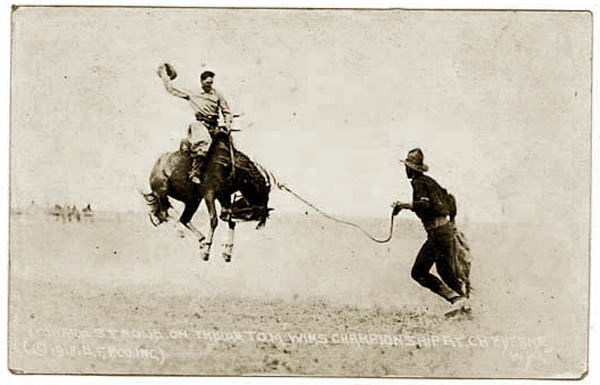
Leonard Stroud on Indian Tom, 1918, photo by Ralph Doubleday.
Over the years other famous riders have appeared. One of the more famous rodeo cowboys was the
1918 Champion, William Leonard Stroud (1893-1961), born in Honey Grove, Fannin County, Texas.
Stroud became famous as a trick rider frequently participating in "Roman Race" events in which the
rider stands astride two horses.
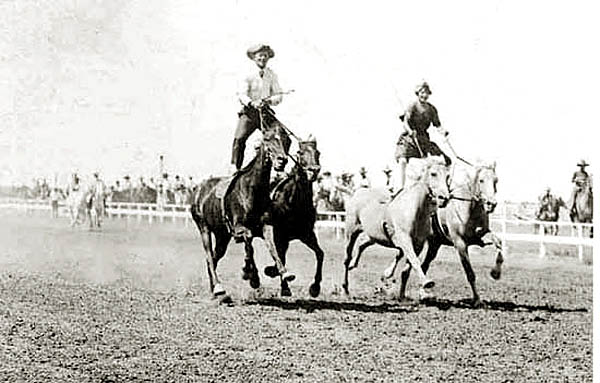
Roman Race, Frontier Days, photo by Ralph Doubleday.
As a trick rider Stroud would ride, as indicated by the next photo, parallel to the ground
while twirling a rope.
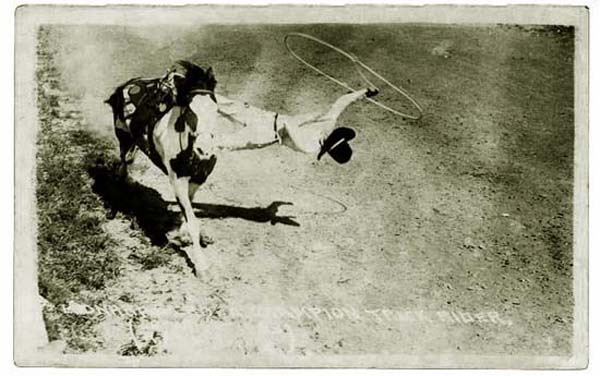
Leonard Stroud on his horse Chief, 1923, photo by Ralph Doubleday.
One of Stroud's tricks was swinging under the horse and coming up on the
other side. This could be a dangerous trick. On one occasion in Colorado he slipped and fell between the
horse's legs, receiving three broken ribs.
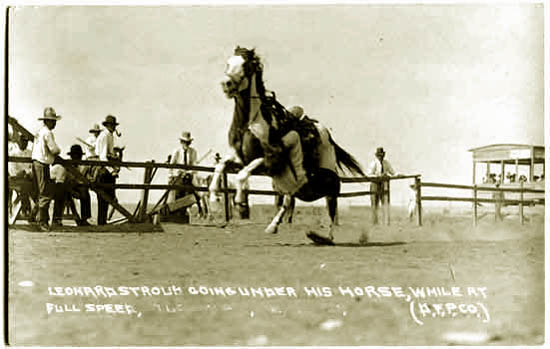
Leonard Stroud swinging under chief. Location undidentified. photo by Ralph Doubleday.
Other trick riders performed a similar but less dangerous trick, going under the horse's neck in front of the horses legs, rather than beneath the
horse between the legs.
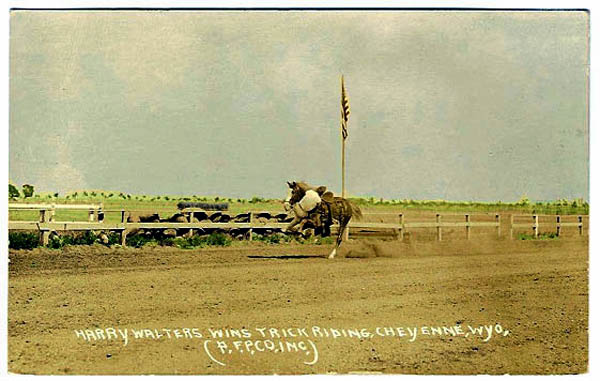
Harry Walters, photo by Ralph Doubleday, 1915.
Harry Walters, (1885-1961) won the trick riding prize 1915. In 1919, he again won first prize beating out Leonard Stroud who won the
previous year. Len did not take it with good grace. As reported by the State Tribune, July 28, 1919:
Stroud in Bad
Leonard Stroud, who was world champion trick ridger and broncho buster up to Saturday afternoon, made himself
unpopular with the crowd when he siezed a megaphone, after the judges had awarded the championship
to Harry Alters and announded that he wanted more rides and a square deal.
Hoots of derision, which Stroud mistook for poplar accalim, greeted his appeal. Poetic justice was meted out in the broncho busing finale, however, when
Stroud went down twice with Vampire, and then demanded a sencond horse.
On Seventh Jump
He got another horse, Corkscrew, and after this animal was saddled in the
chute, and the former champion was seated, the gates were thrown open. On the seventh jump the champion was thrown and thrown hard, to the deep satisfaction of the thousands in the stands.
Walters also won 1914 Frontier Days Broncho Busting Contest and first place at Pendleton in 1918.
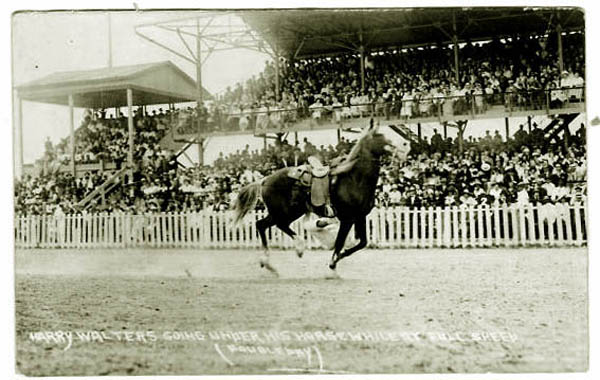
Harry Walters, going under, his horse at full speed. Photo by Ralph Doubleday, undated.
In December 1915, newspaper readers across Wyoming were shocked to learn that Harry had been arrested in Denver for murder and
that his real name was
Jyram J. Sterling. As Sterling, Harry was involved in a dispute with the owner of a "blind tiger" across the street from a livery stable
owned by Harry in Mexis, Texas, about forty miles east of Waco. In the dispute over dogs, the owner of the "blind tiger," an unlicensed saloon,
pulled a gun on Harry. Harry was slightly faster on the draw.
Harry was tried for murder. The jury deadlocked. Five more times Harry was tried, Five more times, the jury was deadlocked. Harry was, however, financial ruined by the
cost of the defense and had to sell his livery stable. The state announced that Harry was to be tied a seventh time.
at that point, according to Harry, rather than have his parents ruined by the cost of a seventh trial, he jumped bail. See Mexia Weekly Herald, January 6, 1916.
Harry fled at first to
Nevada. Harry changed his name at first to "Harry Smith" to match his initials tatooed on his arm.
Subsequently, he changed his name to Harry Walters and became a part of the
Miller Brothers 101 show. Apparently nothing came of the arrest in Denver. By the middle of 1916, he was again back on the circuit competing in among other places in
New York. In 1917, he visited his family in Mexia. There for residents of the town, he put on an impromptu twenty minute demonstration of trick riding. See Mexia Weekly Herald, October 25,
1917. The murder charges were soon forgotten. The Mexia Weekly Herald, July 11, 1941, listed Harry a one of the three great cowboys to come out of Mexia. The others were
his brother Walter E. "Buddy" Sterling (1896-1972) and friend Robert H. "Bob" Sewell (1896-1941).
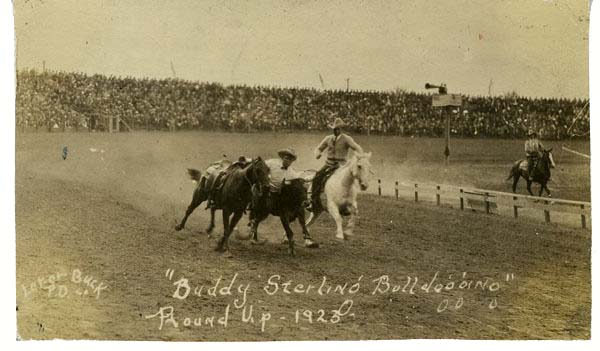
Buddy Sterling, Pendleton, 1923.
Buddy also entered contests at Cheyenne and Pendleton as a steer roper and bulldogger and participated in the
Wembley Empire Exhibition and the ensuing world tour. He rated a special metion in the Singapore Post, Sept 26, 1925 as a world champion steer wrestler. He won
the 1919 Cheyenne steer roping contest. Later he worked for
Will Rogers. Fame, however, is fleeting. His obituary in the Oxnard [California] Press Courier, June 18, 1963, p. 16, rated one paragraph.
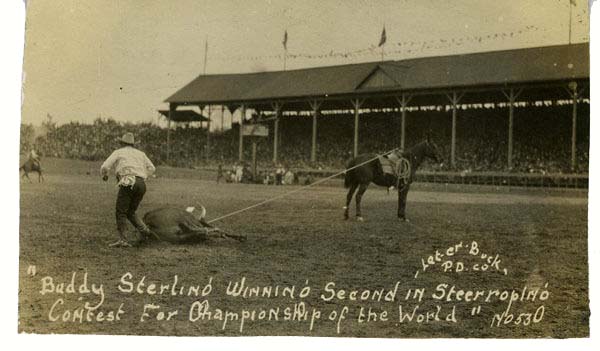
Buddy Sterling, Pendleton, 1923.
Another trick ride performed by Leonard Stroud and Chief was leaping over other horses or, as depicted below, over
motor cars. Stroud for his tricks would use a saddle especially designed and made for him by
N. Porter Saddle and Harness Co., Phoenix, Arix. Porter was a Confederate veteran who originally started making
saddles in Abilene, Tex. and came to Arizona in 1897. After Porter's death in 1906, the business was
carried on by his two sons. Stroud's saddle had auxiliary straps, an extended horn, and
crupper handholds. Stroud was inducted into the Hall of Fame in 1965.
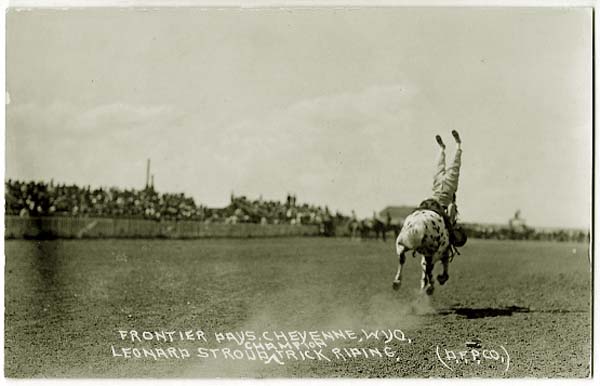
Lenard Stroud doing handstand.
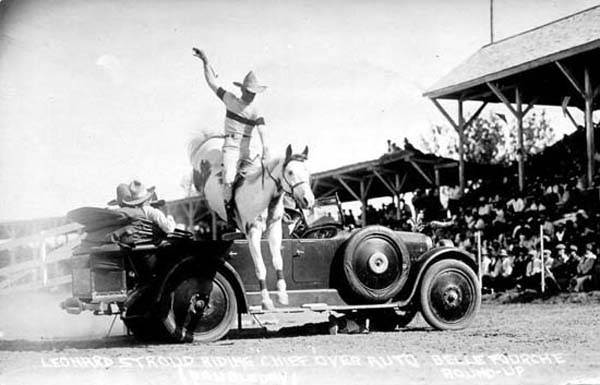
Leonard Stroud at Belle Fourche, photo by Ralph Doubleday.
Music this page: Chariot Race or Ben Hur March by Edward Taylor Paul (1858-1924).
Next page, Frontier Days continued.
|